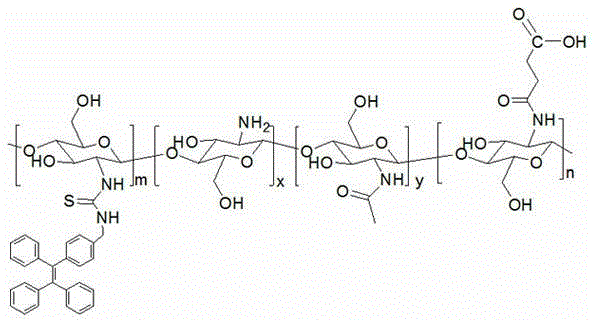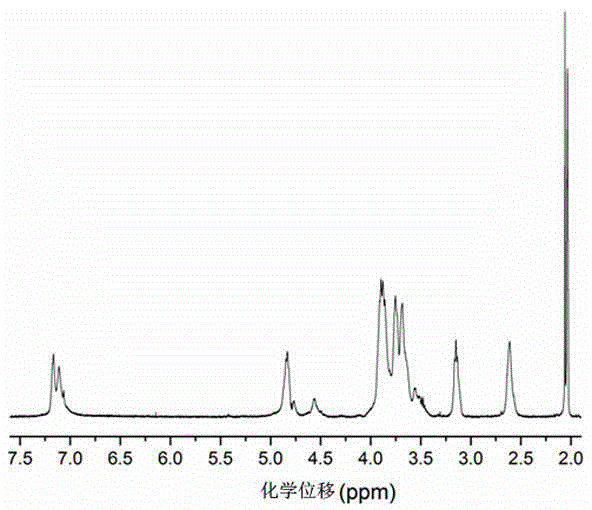Preparation method of water-soluble chitosan-base aggregation-induced light-emitting fluorescent probe
A technology of aggregation-induced luminescence and water-soluble chitosan, which is applied in the direction of luminescent materials, fluorescence/phosphorescence, chemical instruments and methods, etc., can solve the problems of cytotoxicity, achieve good water solubility, high sensitivity, and no drift of fluorescence spectrum Effect
- Summary
- Abstract
- Description
- Claims
- Application Information
AI Technical Summary
Problems solved by technology
Method used
Image
Examples
Embodiment 1
[0015] 1) Weigh 1g of chitosan (viscosity average molecular weight 10,000, deacetylation degree 60%) into eggplant-shaped bottle, add 10mL DMSO, swell at 50°C for 24h, then add TPEITC, TPEITC and The mol ratio of amino group in the chitosan is 1%, reacts 24h, obtains solution A and it is poured in the 250mL beaker;
[0016] 2) Add 200mL of absolute ethanol to solution A, stir evenly, let it stand until the solution is separated, remove the supernatant, and after centrifugation, dissolve the precipitate with 40mL of acetic acid solution with a volume fraction of 2%, and filter to obtain the filtrate;
[0017] 3) Mix tetrahydrofuran and deionized water at a volume ratio of 1:1 to prepare a dialysate, put the filtrate into a dialysis bag with a molecular weight cut-off of 3500 and place it in the dialysate for dialysis for 5 days. NaOH neutralized the filtrate, centrifuged, washed with water and freeze-dried to obtain fluorescently labeled chitosan TPE-CS;
[0018] 4) Weigh 0.5g...
Embodiment 2
[0021] 1) Weigh 1g chitosan (viscosity-average molecular weight 10,000, deacetylation degree 60%) into eggplant-shaped bottle, add 10mL DMSO, swell at 55°C for 24h, then add TPEITC, TPEITC and The mol ratio of amino group in chitosan is 5%, reacts 24h, obtains solution A and it is poured in the 250mL beaker;
[0022] 2) Add 200mL of absolute ethanol to solution A, stir evenly, let it stand until the solution is separated, remove the supernatant, and after centrifugation, dissolve the precipitate with 40mL of acetic acid solution with a volume fraction of 2%, and filter to obtain the filtrate;
[0023] 3) Mix tetrahydrofuran and deionized water at a volume ratio of 1:1 to prepare a dialysate, put the filtrate into a dialysis bag with a molecular weight cut-off of 3500 and place it in the dialysate for dialysis for 5 days. NaOH neutralized the filtrate, centrifuged, washed with water and freeze-dried to obtain fluorescently labeled chitosan TPE-CS;
[0024] 4) Weigh 0.5g TPE-CS...
Embodiment 3
[0027] 1) Weigh 1g of chitosan (viscosity-average molecular weight: 100,000, deacetylation degree: 80%) into an eggplant-shaped bottle, add 10mL DMSO, swell at 55°C for 36h, then add TPEITC, TPEITC and The mol ratio of amino group in chitosan is 10%, reacts 24h, obtains solution A and it is poured in the 250mL beaker;
[0028] 2) Add 200mL of absolute ethanol to solution A, stir evenly, let it stand until the solution is separated, remove the supernatant, and after centrifugation, dissolve the precipitate with 40mL of acetic acid solution with a volume fraction of 2%, and filter to obtain the filtrate;
[0029] 3) Mix tetrahydrofuran and deionized water at a volume ratio of 1:1 to prepare dialysate, put the filtrate into a dialysis bag with a molecular weight cut-off of 3500 and place it in the dialysate for dialysis for 6 days. NaOH neutralized the filtrate, centrifuged, washed with water and freeze-dried to obtain fluorescently labeled chitosan TPE-CS;
[0030] 4) Weigh 0.5...
PUM
 Login to View More
Login to View More Abstract
Description
Claims
Application Information
 Login to View More
Login to View More - Generate Ideas
- Intellectual Property
- Life Sciences
- Materials
- Tech Scout
- Unparalleled Data Quality
- Higher Quality Content
- 60% Fewer Hallucinations
Browse by: Latest US Patents, China's latest patents, Technical Efficacy Thesaurus, Application Domain, Technology Topic, Popular Technical Reports.
© 2025 PatSnap. All rights reserved.Legal|Privacy policy|Modern Slavery Act Transparency Statement|Sitemap|About US| Contact US: help@patsnap.com


